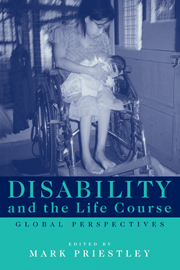Book contents
- Frontmatter
- Contents
- List of figures
- List of tables
- Notes on contributors
- Preface
- Acknowledgements
- A brief note on terminology
- I Concepts
- II Methods and stories
- III The politics of transition
- 13 Disabled children: an emergency submerged
- 14 Failing to make the transition? Theorising the ‘transition to adulthood’ for young disabled people
- 15 Breaking my head in the prime of my life: acquired disability in young adulthood
- 16 Work and adulthood: economic survival in the majority world
- 17 The possibility of choice: women with intellectual disabilities talk about having children
- 18 Ageing with disability in Japan
- 19 Ageing with intellectual disabilities; discovering disability with old age: same or different?
- 20 Epilogue
- Index
18 - Ageing with disability in Japan
Published online by Cambridge University Press: 30 September 2009
- Frontmatter
- Contents
- List of figures
- List of tables
- Notes on contributors
- Preface
- Acknowledgements
- A brief note on terminology
- I Concepts
- II Methods and stories
- III The politics of transition
- 13 Disabled children: an emergency submerged
- 14 Failing to make the transition? Theorising the ‘transition to adulthood’ for young disabled people
- 15 Breaking my head in the prime of my life: acquired disability in young adulthood
- 16 Work and adulthood: economic survival in the majority world
- 17 The possibility of choice: women with intellectual disabilities talk about having children
- 18 Ageing with disability in Japan
- 19 Ageing with intellectual disabilities; discovering disability with old age: same or different?
- 20 Epilogue
- Index
Summary
The world is rapidly ‘greying’ due to an increasingly ageing population. From ancient times, humans have dreamed of longevity and eternal youth. Thanks to medical advancements, life expectancy has drastically increased, and one half of our wishes are almost granted. Now, we are no longer satisfied with merely living longer, we expect to stay healthy and independent too. The rapid growth of an ageing population has resulted in much general interest in ageing, and there is now an abundance of research pertaining to ageing and disability. As one might expect, this is because a perfect correlation exists between population age and the number of people with impairments (Coni et al. 1992).
Ageing takes places in cultural milieus. Different cultures, with different traditions and customs, mirror various ageing realities (Hashimoto 1993; Sennet and Czarniecki 1991). Although the ‘greying’ phenomenon can be seen in many developed nations, Japanese society is facing a tougher challenge, because population ageing here is coupled with decreasing birth rates and an increasing number of nuclear families (Hashimoto 1993). In fact, life expectancy for the Japanese, especially for women, is the longest in the world at 83.1 years (Freed 1990) and many elderly Japanese have disabilities.
Although the population of Japanese with impairments constitutes 4.8 per cent of the total population, ageing has become a prominent topic (Sori-fu 1998). A national poll, taken by the Japanese government, illustrates a sharp generational divide (Sori-fu 1998).
- Type
- Chapter
- Information
- Disability and the Life CourseGlobal Perspectives, pp. 219 - 230Publisher: Cambridge University PressPrint publication year: 2001
- 2
- Cited by



